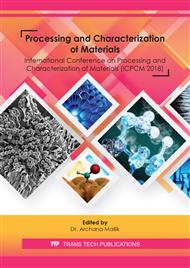p.21
p.29
p.34
p.40
p.49
p.55
p.64
p.77
p.84
Experimental Analysis of Canola Oil as Dielectric Fluid in Electric Discharge Machining of AISI D2 Steel
Abstract:
Electric Discharge Machining (EDM) is a thermo-electrical disintegration process, utilized to cut hard materials into complex shapes. In EDM, the three vital components are work-piece material, electrode material and dielectric liquid. The significant function of the dielectric fluid is to produce a breakdown voltage for creating a spark between work-piece and electrode. This spark creates ionization by plasma generation and it expels the material from work-piece. In most cases, hydrocarbon-based dielectric liquid is preferred in the EDM process. This kind of dielectric liquid generates hazardous gases which are harmful to people, environment and ecological balances. In this experiment, Canola oil is utilized and the outcomes are compared. The input parameters are Pulse on/off time, current and gap voltage. Copper, Brass and Tungsten-Copper (Alloy) are used as electrodes. The output values from the experiments are Surface Roughness (SR), Electrode Wear Rate (EWR) and Material Removal Rate (MRR). The outcomes demonstrated that Canola oil-based dielectric fluid has comparable properties of conventional based dielectric fluid. This Canola based dielectric gives more prominent MRR value than EDM oil-based dielectric liquid and furthermore higher EWR and SR values are recorded. The proposed Canola oil-based dielectric fluid is biodegradable and has improved suitability in machining.
Info:
Periodical:
Pages:
49-54
Citation:
Online since:
February 2020
Keywords:
Price:
Сopyright:
© 2020 Trans Tech Publications Ltd. All Rights Reserved
Share:
Citation:


